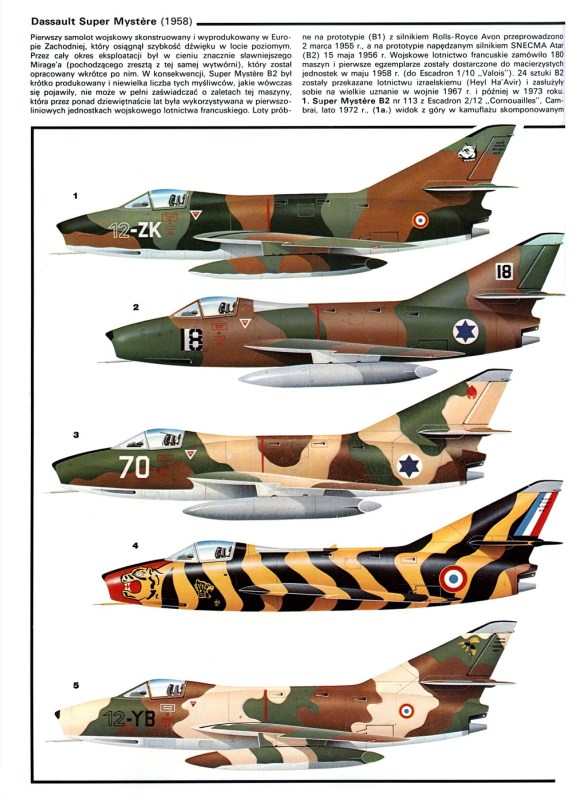The French Mystere series of aircraft was among the most important to appear in the West and maintained France’s indigenous aircraft industry. A variety of Mystere aircraft was produced to meet many different national needs.
The first prototype of the Super Mystere B. 1 flew on 2 March 1955, powered by a Rolls-Royce Avon R. A. 7R turbojet. The first of five Atar-powered preproduction Super Mystere B. 2s followed on 15 May 1956. The primary role of the Super Mystere B. 2 was that of day interceptor, but a variety of underwing stores made it suitable for the fighter-bomber role. The Super Mystere B. 2 equipped two squadrons of the 5th Armée de l’Air and one squadron of the Israeli Air Force.
The Super Mystere represents the final step in evolution which began with the Dassault Ouragan and progressed through the Mystere II/III and Mystere IV. While earlier Mystere variants could attain supersonic speeds only in a dive, the Super Mystere could exceed the speed of sound in level flight. This was achieved thanks to the new thin wing with 45° of sweep (compared with 41° of sweep in the Mystere IV and only 33° in Mystere II) and the use of an afterburner-equipped turbojet engine.
The first prototype Super Mystere B. 1, powered by a Rolls-Royce Avon RA. 7R, took to the air on March 2, 1955. The aircraft broke the sound barrier in level flight the following day. The aircraft entered production in 1957 as the Super Mystere B. 2. The production version differed from the prototype by having a more powerful SNECMA Atar 101G engine. In 1958, two Super Mystere B. 4 prototypes were built. Equipped with a new 48° swept wing and a more powerful SNECMA Atar 9B engine, the aircraft were capable of Mach 1.4. Production never materialized because the faster Dassault Mirage III was entering service. In 1973, the Israeli Air Force and Honduras Air Force upgraded their Super Mystere B. 2s with a non-afterburning version of the Pratt & Whitney J52-P8A and new avionics. They were called Sa’ar (Storm).
#
The Super-Mystere B 2 was a development of the Super-Mystere B 1 but equipped with the Snecma Atar 101 G preferred by the Air Force. After the good results attained by the Super-Mystere B 1 and in anticipation of improvements with the larger central plane of the Super-Mystere B 2 dont le plan central a été agrandi, Marcel Dassault began negotiations with the authorities to produce the B 2 in lieu of the Mystere IV B ordered 1954. On March 29, 1955, the DTIA accepted and terminated the Mystere IV B contract, ordering:
100 further Mystere IV A with the Verdon jet engine 5 pre-production Mystere IV B 2 with the fuselage and wing of the B 1and the Atar G 32 jet engine 40 Mystere IV B2 with spare parts, plus servicing and maintenance tools
The production order was subsequently raised to 220 and then reduced to 178, which were delivered between 1957 and 1959. The Super Mystere B 2 01 made its 40-minute maiden flight at Melun-Villaroche on May 15, 1956, piloted by Gérard Muselli; it broke the sound barrier without using its after-burner. The first production-standard aircraft flew at Mérignac on February 26, 1957 and the first examples were delivered to the 10th Creil Fighter Wing in May of 1958.
Against a background of defense cuts, only 154 aircraft were delivered to the Air Force, of which two (under the name Super-Mystere B 4) were set aside as flying test-beds for the Snecma Atar 9.
In 1958, Israel ordered 24 Super-Mystere B 2. They took part in the Six-Day War of 1967 and the Yom Kippur War of 1973. En 1977, 18 second-hand Israeli models, with new American Pratt & Whitney J 52 engines without after-burners were sold to Honduras.
The SMB 2 served in the French Air Force until 1974.
